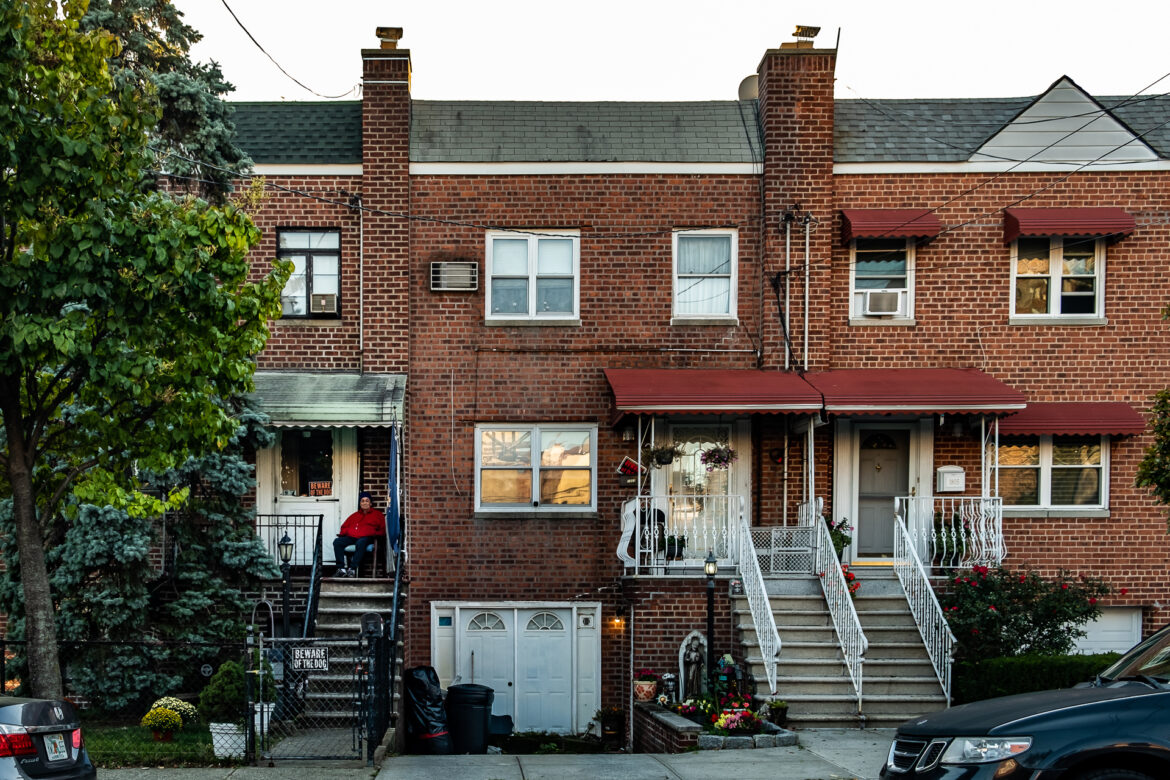As much of the country grapples with an affordable housing shortage, host-home and home sharing programs—which typically pair people who have a room to spare with those in need of a place to live—are a growing intervention.

Adi Talwar
Homes along Tomlinson Avenue in Morris Park, The Bronx.Mary P., a 78-year-old who asked City Limits to withhold her full name for privacy reasons, has been renting out the spare room of her City Island bungalow in the Bronx for five years.
It started when her previous roommate said she was moving to Florida. Mary remembered a newsletter ad attached to her ConEdison bill about a home-sharing program offered by the New York Foundation for Senior Citizens, and has been working with the group to vet potential roommates ever since.*
“Rather than have to screen them myself, I relied on the program,” Mary said, “who investigated me as well as them.” Her only complaint with her current match is relatable: “I can’t walk around naked.”
As New York City and much of the country grapples with an affordable housing shortage, host-home and home sharing programs—which typically pair people who have a room to spare with those in need of a place to live—are a growing intervention.
Supporters say the arrangement can be especially helpful in serving vulnerable populations, like homeless LGBTQIA+ youth or those on fixed-incomes.
“The model of care leans on the concept that we all benefit from mutual support,” said Julia Terry, a staff member for Point Source Youth, a national nonprofit focused on ending youth homelessness.
For unhoused young people, “a successful hosting experience often results in long-lasting connections to trusted adults, which mitigates risks associated with continued instability in the housing continuum,” Terry added. “Keeping young people connected to places and spaces of belonging as they stabilize.”
The city of Portland, Maine, expanded a home share program this past July in an effort to move asylum seekers from shelter into more permanent housing.
In New York, more than 69,000 newly arrived immigrants are living in the city’s shelters—a number the Adams administration has sought to lower by issuing time limits on their stays, saying the city has run out of space and funding.
“One of the main benefits of the host home model is its relatively low cost compared to brick-and-mortar housing programs,” Terry said. “Left out of the conversation is the need for diverse, flexible, funding supports that recognize the need for Host Home programs to retain adaptability.”
‘To relieve feelings of isolation and loneliness’
New York City and State governments fund at least one such program: New York Foundation for Senior Citizens, which receives support from NYC Aging and the New York State Offices for the Aging and People with Developmental Disabilities, has been making home sharing matches since 1981.
The initiative, of which Mary P. is a participant, focuses on matches between seniors over 60 and younger housemates as a way to prevent both groups from becoming homeless due to rising rents, medical expenses, or death of a partner. The goal is also to provide companionship and financial stability for both parties.
“We’ve helped people get out of foreclosure by doing this service and also to relieve feelings of isolation and loneliness,” said Linda Hoffman, the foundation’s president. The program has matched over 2,500 pairs in the last four decades, and some have lasted over 20 years.
Hoffman explained how the process works: Foundation staff conduct intensive interviews, background checks and screen the references of all applicants for free.
The host and guest agree on specific terms of their living arrangement, which the nonprofit writes into a license agreement, rather than a new lease with both applicants’ names on it.
License agreements can state terms like how much financial support each person will pay, service exchanges—like driving the senior to grocery stores or doctor appointments—whether alcohol or visitors are allowed in the house, or other conditions the roommates would like to include.
Hoffman credits her group’s 42 years of success to a very careful matching and screening process, and described the license agreements as “iron-clad.”
The foundation’s staff are all licensed in social work and use a computer program called Quick Match to pair potential hosts and hostees based on location, income, and service exchanges. Then the team conducts background checks and calls non-related references.
Anyone can apply to the program and those interested in being a host or a housemate can connect with the Foundation through its website. It has matched queer identifying people, those with disabilities, and unhoused people with hosts.
Hoffman believes home-sharing is a tool that can help relieve the city’s homelessness crisis, as more than 147,000 people stayed in the shelter system in November, the most recent month for which a complete count is available.
While the average length of stay for New Yorkers in shelter was shorter in Fiscal Year 2023 than the year prior, it still took a significant amount of time for those in the system to move from shelter to housing: families with children that year spent an average of 437 days in shelter, single adults 412 and adult families 750 days.
Hoffman said that if housing vouchers, the most common type of city rental assistance, could be used towards license agreements rather than as a subsidized payments directly to a landlord, the program could include many more people who are currently homeless.
“I don’t know what the laws are regarding it, but that would really help,” she said.

Adi Talwar
Doobneek, who was homeless for two years in the city, said they would have considered joining a host-home program if it was an option, saying the model offers a more dignified setting than many shelters.‘A way to create family structures’
Separately, the Hetrick-Martin Institute, one of the longest running programs that serves LGBTQIA+ youth in the country, is spearheading New York City’s first host-home program specifically for unhoused, queer young adults who range from age 18 to 25.
It’s still early days for the program, which aims to find supportive host homes for 40 participants by the end of December 2024. For now, the initiative is available only to members of the institute’s ballroom community, a social platform for Black and brown queer-identifying youth to express their identities and talents, and make relationships that they may not have with their biological families.
“It’s a community built of high-risk, under-served populations,” said Jermaine Ellis, the group’s director of program operations and community engagement. “People, they find these networks as a way to create family structures. The idea is: ‘I’m supporting you because you may have been kicked out of your home.’”
Queer youth make up just 4.5 percent of the general population, according to the state’s Office of Children and Family Services, but make up almost a third of the city’s homeless youth, and often face increased risks of violence and lack of family support.
Doobneek, who legally goes by first name only, is a queer asylum-seeker who was homeless for two years in the city, and said they would have considered joining a host-home program if it was an option at that time.
After leaving Russia in 2019, they were homeless for two years and living at a shelter for queer homeless youth. They were still waiting on a work permit, and so were ineligible for some permanent housing programs. “Housing programs for youth are deceiving, saying there is no immigration status requirement, but we require you to legally work,” Doobneek said of the catch-22. They described their time in the shelter as “horrible.”
“There were fights, there was sexual violence, theft, threats,” said Doobneek, who now works for at Streetlives, a technology platform for unhoused people to find, rate and review social services. “And you hear all that, you cannot avoid it.”
Both Doobneek and Terry said the benefits of host home programs include settings that are more dignified than many shelters. In a home, guests can receive direct mail, cook their own food, do laundry, access their belongings at all times, and have quiet time to study and sleep.
“The personal home-based environment,” Terry said, is “in deep contrast to sheltering systems.”
The program plans to support host-home matches to last between six months and a year. Hosts will receive stipend payments between $500 to $1,000 per month to cover costs like food, shelter and electricity. Meanwhile, a team of case managers will help participating youth attain permanent housing after their match period is up.
Hetrick-Martin Institute’s home-host program is funded by the Youth Homelessness Demonstration Program, a federal initiative by the U.S. Department of Housing and Urban Development.
The program is onboarding a staff of attorneys, case managers, social workers and peer navigators, who will help participants navigate any issues that could potentially arise in their matches.
“We have case managers who will support and be in touch with the youth throughout the six months,” said Christopher Johnson, the institute’s program manager of host homes and a licensed clinician. “The goal is to sustain the match, and once the support is there, helping that youth be independent, getting employment, going to school, whatever they would like to do in terms of getting housed permanently.”
For Mary P., the home-host experience has had its ups and downs: She was previously matched with one woman whom she described as “pushy,” who wanted visitors and neighbors at the house often. Her program’s license agreements allow both a host and resident to give 30 days notice if they’re not okay with the arrangement, and just before Mary considered giving notice, the other woman did.
She’s had a better experience with her current housemate, a 68-year-old man who has lived with her since December. The two take turns deep cleaning the house, and he helps her feed her cat, carry packages into the apartment and drives her to the supermarket.
She said she’d happily sign another license agreement with him for the next two years.
“I had slight misgivings about having a man instead of a woman,” she said, “but he’s perfectly proper and very quiet and respectful.”
To reach the editor, contact Jeanmarie@citylimits.org
*This story has been updated since original publication to correct the name of this nonprofit; it is the New York Foundation for Senior Citizens, not the New York State Foundation for Senior Citizens. City Limits regrets the error.








